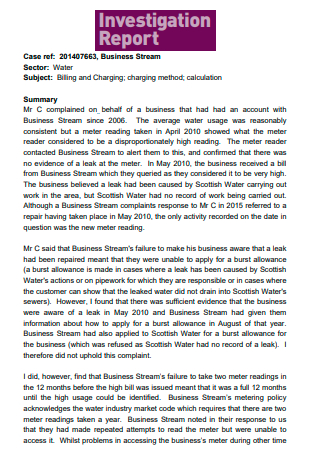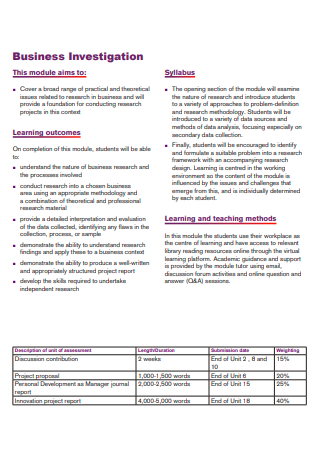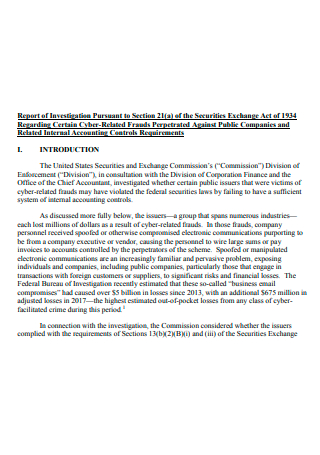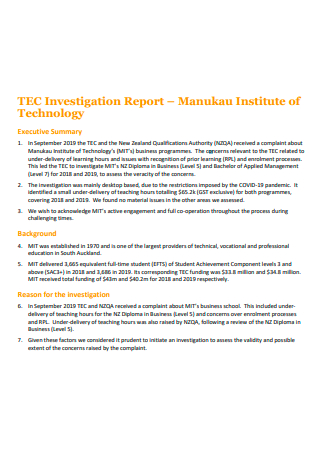4+ Sample Business Investigation Report
FREE Business Investigation Report s to Download
4+ Sample Business Investigation Report
What Is a Business Investigation Report?
3 Kinds of Business Investigations That Can Save Companies:
7 Qualities Found in a Professional Investigator:
Top 8 Investigation Report Essentials:
Steps on How to Make a Business Investigation Report:
FAQs
What is the role of a business investigator?
How do you conclude an investigation report?
How do you answer questions in a business investigation?
What are the mistakes to avoid during business investigations?
What Is a Business Investigation Report?
When there is a strong collection of evidence of misconduct, malfeasance, or ethical gaps, a business investigation is performed. The goal of the investigative report should be to notify and advice. Businesses conduct a thorough examination to disclose any possible vulnerabilities or fraud. A precautionary and countermeasure action are both part of a business investigation.
By doing an investigation, a company can avoid threats and lessen damages in the case of a fraudulent scheme. An investigation report consists a variety of objectives. It is a document that, based on the official conclusions it gives, prompts some type of action. This might comprise dismissal, disciplinary action, training, and counseling, depending on the result of the investigation. The report should be comprehensive and should avoid any prejudice in the report by keeping it as brief and straightforward as possible.
An investigative report is a document that specifies the conclusions of an investigation as soon as a formal complaint is filed or an incident occurs. This is where investigators track the issues of the matter, analyze the evidence, and formulate a conclusion. It is impartial and based on evidence, not on the opinions of an investigator or the parties involved.
3 Kinds of Business Investigations That Can Save Companies:
Business investigation report is a thorough investigation done by businesses to reveal any possible risks or fraud. It comprises both preventive and countermeasure action. By conducting investigation, a business can prevent risks from happening and minimize loss if a fraudulent action ever takes place. Generally, there are three kinds of business investigations based on your needs, which are:
7 Qualities Found in a Professional Investigator:
Here is a list of qualities found in a professional investigator:
Professionalism
As a professional investigator, you have to be extremely professional. This is a quality required for any career stream. You have to be committed to the tasks you undertake and have an inclination towards continuous improvement and excellence. This goes a long way in building credibility and reputation in your field.
Integrity
As an investigator, you will be dealing with a variety criminal cases where you would have access to people’s private lives. One of the most important virtues of a professional investigator is integrity. It is up to you to be discreet and confidential about your work and to not use this information in ways that is inappropriate.
Persistence
A professional investigator does not have the option of giving up. Investigating cases of fraud and crime can be frustrating at times. This is because, most criminal require persistent and proactive work until the end when the case is closed.
Self-Driven
You do not have someone else directing your work. When you are a professional investigator, you are mostly working tirelessly on your own. It is you who decides everything. In order to be a professional investigator, you have to be self-driven.
Problem Solver
You will need the analytical skills and the ability to think rationally and clearly. Only a good problem-solver will be able to work under immense pressure and successfully close the case.
Reliable
You should be reliable and keep your client up to date on all progress. When people come to you with their private cases, you have to be able to give them the assurance that you will help them with their problem. People should have complete faith in your ability to evaluate cases and unmask the culprit.
Courage
You might have to deal with people who are potentially unsafe for you. The job of a professional investigator can be risky at times. You should be prepared to deal with all kinds of situations to become a true and successful professional investigator.
Top 8 Investigation Report Essentials:
A standardized reporting structure improves the consistency of reports amongst investigators, provides investigators with a reporting format to follow and reduces the time spent preparing investigation reports. Writing investigation reports does not have to be daunting.
Information to Identify the Case
Begin the report with case-specific information that identifies the case the report is related to. Include information such as the investigator’s name, case number, the date the case was entered, and the date it was assigned to the investigator.
Referral Source
The next section should include the complainant’s information. The complainant’s work phone number, e-mail, employee number, office location, department, and job title help identify the person lodging the complaint.
Allegation Details
Harassment, discrimination, retaliation: what type of allegation is under investigation? In this section, be sure to include as much detail as possible about the initial complaint: type of case; who the alleged victim is (may or may not be the same person as the complainant); how the complaint was received: hotline, face-to-face, web form; and allegation details: what happened, where, when and any other information provided in the initial complaint.
Investigation Scope or Purpose
Answer the question, “what is the investigation trying to prove?” Include a statement that describes the mission and objectives of the investigation.
Interview Summaries
List the investigation interviews that took place throughout the investigation. Ensure that the list is in chronological order, beginning with the first interview, ending with the last. Summary details are short:
- Name of the interviewer: also include the names of any other people who sat in on the interview
- Name of the person interviewed and their role in the investigation: complainant, subject, witness
- Interview location
- Date of interview
There is no need to go into detail about the events of the investigation.
Interview Reports
Interview reports are brief summaries of each of the investigation interviews. In addition to the information in the above section, this part elaborates on the investigation interview to include:
Credibility Assessment: Certain factors will determine the credibility of an interviewee’s statements. This section of the report should list any indicators that contribute to the belief that the interviewee is or isn’t a credible source.
Investigator Notes: In the introduction, outline the explanation of the interviewer’s role in the investigation, the purpose for the interview, efforts to maintain confidentiality and retaliation protections. Summarize the introduction, incident overview, and conclusion of each interview. The incident overview section should include the interviewee’s description of events related to the incident, whether or not they are aware of any witnesses, where/when the incident occurred and any background information linking the involved parties. Notes to be made about the interview conclusion should include thanking the interviewee, reiteration of confidentiality concepts, review of statements made and interviewee signing of investigator notes.
List of Evidence
As simple as it sounds, list the evidence gathered during the investigation. For the sake of the investigation report, include information such as:
- Type of evidence collected: interview, video, photo, audio tape, e-mail, etc.
- Name of person who presented the evidence, as well as their role in the investigation
- Location of the evidence
- Date the evidence was collected
Recommendations
Conclude the report with recommendations. After reviewing all of the investigation materials, what type of action should be taken? Does evidence support the violation of workplace policies?
Make sure recommendations are backed up by the consequences outlined in the company code of conduct or other policies governing employee behavior in the workplace. Include a plan of action, identifying next steps in taking corrective action.
Steps on How to Make a Business Investigation Report:
A Business Investigation Report assists you in writing a report that is consistent across investigators’ reports, gives investigators with a reporting structure to follow, and cuts down on the time spent producing investigation reports. Choose any of the excellent and downloadable templates listed above so that you can be ensured that you have a well-written and complete report, and that you do not have to go through with the hassle of writing one from scratch. Other than that, if you want to write one on your own, follow these steps below to guide you:
-
Step 1: In Order to Identify the Case, You Will Need to Supply the Following Information
Begin your report with case-specific information that identifies the case to which it pertains. Include details like the investigator’s name, case number, the date the case was entered, and the date the investigator was assigned to the case.
-
Step 2: Provide the Referral Source
The information provided by the complaint should be included in the next section. The complainant’s office phone number, e-mail address, employee number, office location, department, and job title all help to identify the person who filed the complaint.
-
Step 3: Include the Investigation’s Accusation Specifics
What sort of complaint is being investigated: harassment, discrimination, or retaliation. Include as much information about the initial complaint as possible in this area. Provide the following below:
- Determine the sort of situation you’re dealing with.
- What method was used to receive the complaint: hotline, face-to-face, web form, etc.
- The complainant and the alleged victim may or may not be the same individual.
- Details of the allegation, including what happened, where it happened, and when it happened, as well as any other information supplied in the first complaint.
-
Step 4: Make a Scope of the Investigation and Case Notes
A summary of the duties assigned and actions done throughout the inquiry should be included in the case notes section. Include a statement that explains the investigation’s aim and goals. And also, include a brief explanation of the task, the actions required to execute it, and who and when the assignment was done.
-
Step 5: Make a List of Possible Recommendations
Make suggestions at the end of the report. Include a plan of action that identifies the next steps in correcting the problem. Make sure your suggestions are backed up by the penalties stated in the business code of conduct or other workplace regulations.
FAQs
What is the role of a business investigator?
Corporate investigators, also known as financial investigators and fraud investigators, are trusted by different companies, businesses, and organizations looking to prevent fraud, embezzlement, and misconduct.
How do you conclude an investigation report?
Conclusion should state things that are unique for every investigation which can be completed by including values of the experimentally determined physical quantities. Just take note that you cannot write your conclusion without completing your experiments or investigations.
How do you answer questions in a business investigation?
You should not be sitting and telling the investigator long stories, but only answer specific questions asked. Your task is to only answer specific questions asked by the investigator. Once you answer the question asked, stop talking, and just wait for the next question. This will make the process much easier, clearer, and quicker.
What are the mistakes to avoid during business investigations?
Business investigations can be time consuming and exhausting but, despite of that, there are not a time where it is okay to cut corners. Here are some common business investigation mistakes: not having an exact and clear way for employees to report problems; moreover, it is a problem to not have a general guideline for how an investigation will be conducted; allowing relevant information to be ignored or destroyed; failing to thoroughly document the investigation; waiting too long to start an investigation; allowing personal biases to cloud judgment or influence the investigation in any way; stopping the investigation before getting all of the facts; not taking steps to ensure that the evidence you find is accurate; not training managers on retaliation; not creating a formal summary report of the findings; and not creating a plan for follow-up—and then acting on it.
The intention of an investigation is to establish important facts to prove or disprove allegations of fraud and corruption. It is a legally established fact-finding process conducted in an impartial and objective manner, with the goal to establish the relevant facts and make recommendations in this connection.
In addition, the conclusion is intended to help the reader understand why your research should matter to them after they have finished reading the paper. A conclusion is not solely a summary of your points or a re-statement of your research problem but a synthesis of key points.
In documenting the investigation, it is important that the investigator is mindful of the terms he or she uses. Avoid stating conclusions that include terms such as harassment, discrimination, or wrongdoing. Rather, terms such as inappropriate, unprofessional, or policy violation should be used.





